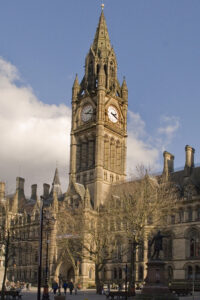Trams have existed since the 1800s. Interestingly, the very first passenger tram was established in Wales in the United Kingdom.
Today, numerous cities around the world have tram systems, including Paris, Vienna, and of course, let’s not forget about London.
Riding a London Tram is definitely recommended if you want to get around the city without spending a fortune.
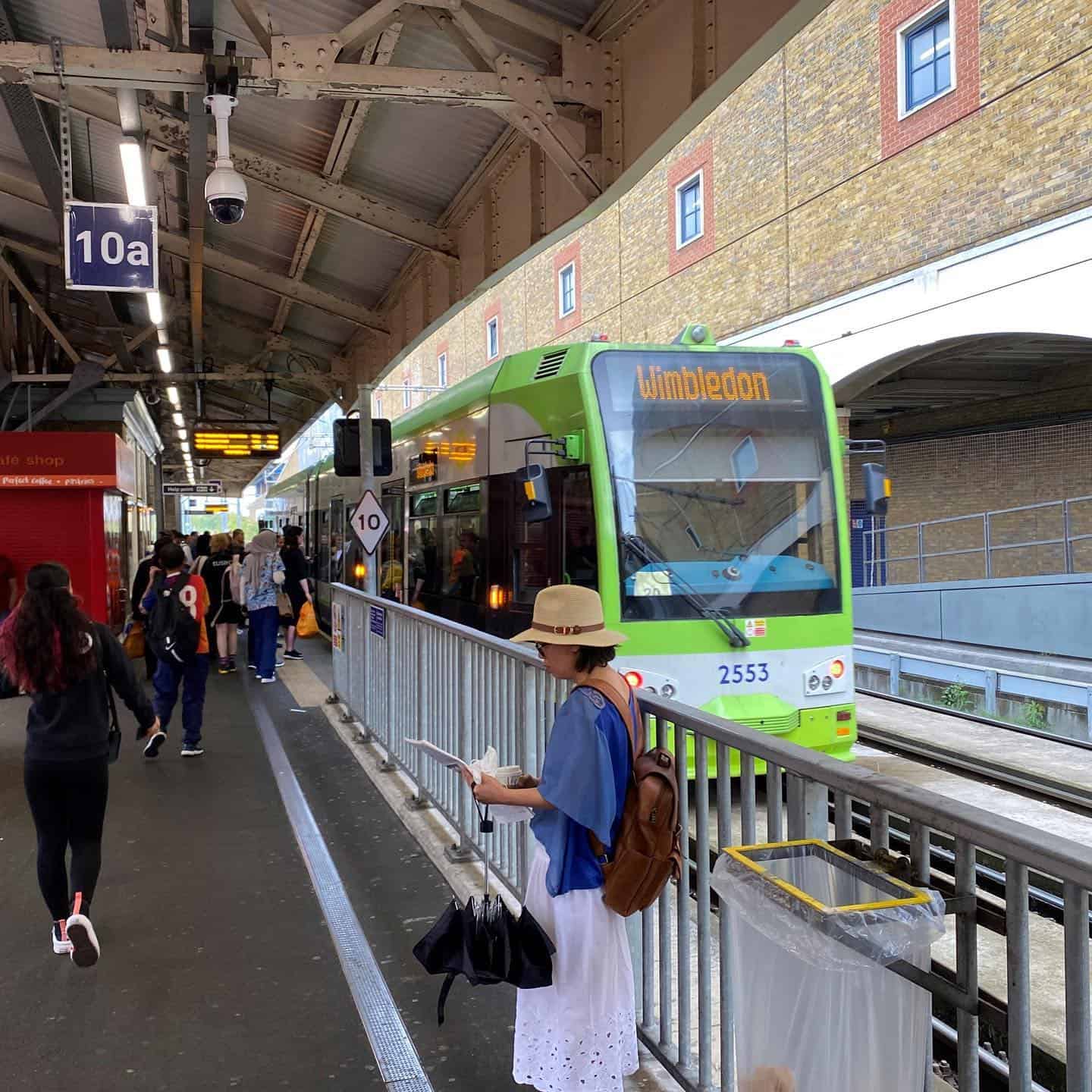
You may know it as Tramlink or Croydon Tramlink, servicing Beckenham, Croydon, New Addington, Wimbledon, and other areas in South London. It currently has 39 Tram Stops that are managed by the Transport for London (TfL).
Approximately 27 million journeys are made every year with a London Tram. If you want to try going on a journey on a tram, read this detailed London Tram guide before doing so.
Some other public transportation options you must know when travelling in London.
- London Underground
- London Bus
- London River Bus
- London Bike Rental
- London DLR
- London Overground
- London Cable Cars
- Driving in London
- Taxis in London
This article covers the following must-know topics:
- London Trams History
- Where Are Trams in London
- London Trams Map
- Trams London Timetable
- How to Pay London Trams
- London Trams Fares
- How to Use London Payment Cards at Trams
- Bus & Tram Discount Photocard
- Recreational Places near Tram Stops
- Frequently Asked Questions
Contents
- 1 London Trams History
- 2 Where Are Trams in London
- 3 London Trams Map
- 4 Trams London Timetable
- 5 How to Pay London Trams
- 6 London Trams Fares
- 7 How to Use London Payment Cards at Trams
- 8 Bus & Tram Discount Photocard
- 9 Recreational Places near Tram Stops
- 10 Frequently Asked Questions
- 11 Ride a Tram on Your Next London Trip
London Trams History
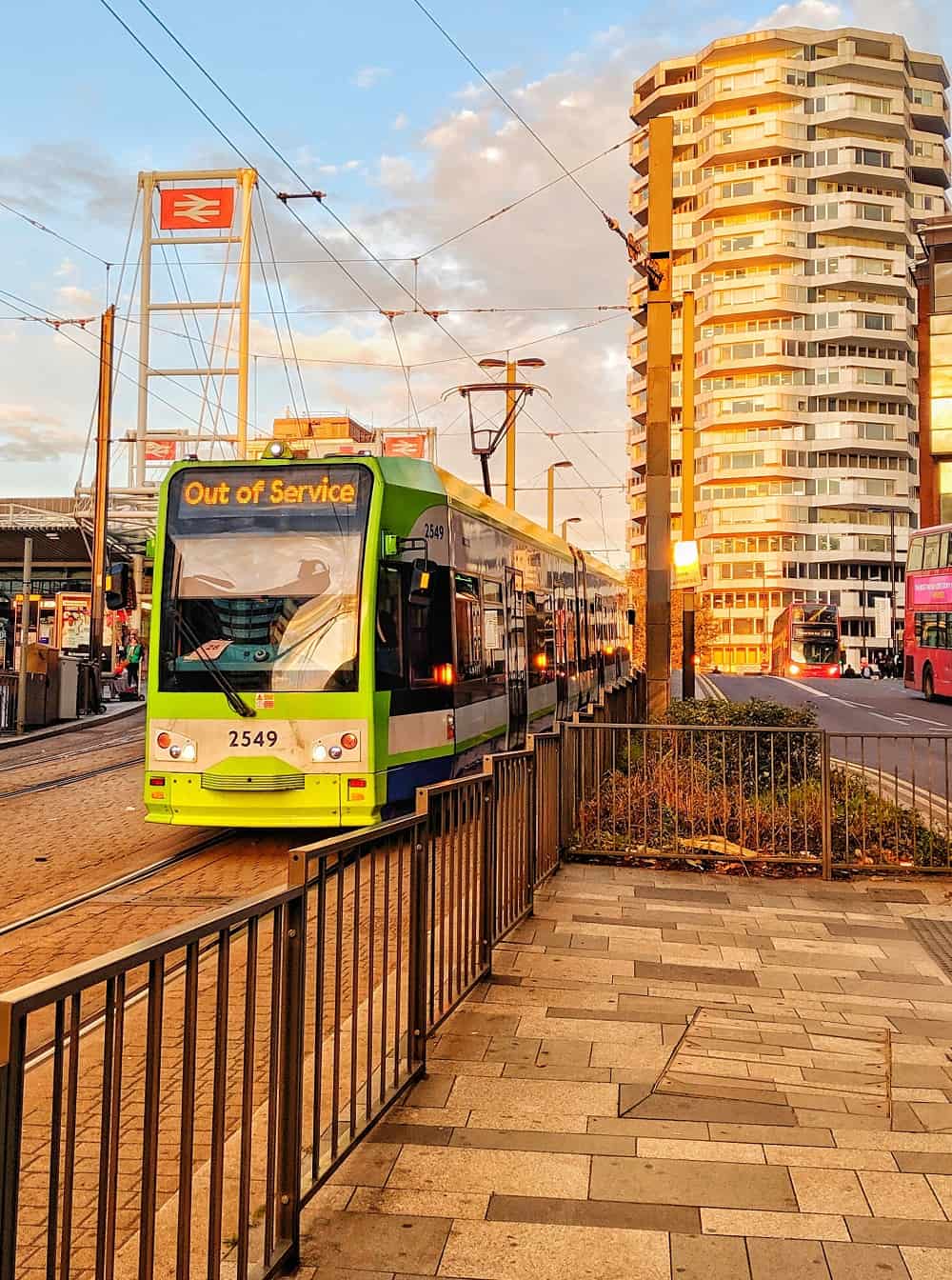
As you take a ride through London’s hundreds of years of tram history, it would be a great idea to first learn a thing or two about its development.
London Trams have been part of London’s long history since 1860. It first opened to the public between 1860 and 1952 and reopened again in May 2000.
You are probably wondering – Why did London get rid of Trams between 1952 and 2000? For many reasons, London Trams were perceived as outdated because of the advancing transportation and abundance of alternatives such as buses, cars, and trains.
With the development of the new motorized public transport system, Trams were slowly closed down until 1952.
In fact, the last tram journey in 1952 was ridden on July 6th, from Woolwich Tram Stop to New Cross Tram Stop.
However, as traffic grew in the 1980s, London Regional Transport considered trams as the ultimate solution to this predicament.
As a result, trams were reintroduced on May 10, 2000, with routes from Croydon to New Addington, followed by another route from Croydon to Beckenham Junction on May 23rd, and from Elmers End to Wimbledon on May 30th.
At present, the London Trams are owned by TfL and operated by FirstGroup. It currently has three routes, 39 Tram Stops, and more than 30 vehicles, running through a track length of 28 km or 17 mi. The maximum speed is about 70 kph or 43 mph.
Where Are Trams in London
Trams are found in areas in South London on three routes: Beckenham Junction to Wimbledon, Elmers End to Wimbledon, and New Addington to Church Street.
There are 39 tram stations or stops across the three routes. Some of the tram stops are connected to London buses, Tube, London Overground, and National Rail services.
Here is a list of the 39 Tram Stops in alphabetical order:
Tram Stops
- Addington Village
- Addiscombe
- Ampere Way
- Arena
- Avenue Road
- Beckenham Junction
- Beckenham Road
- Beddington Lane
- Belgrave Walk
- Birkbeck
- Blackhorse Lane
- Centrale
- Church Street
- Coombe Lane
- Dundonald Road
- East Croydon
- Elmers End
- Fieldway
- George Street
- Gravel Hill
- Harrington Road
- King Henry’s Drive
- Lebanon Road
- Lloyd Park
- Merton Park
- Mitcham Junction
- Mitcham
- Morden Road
- New Addington
- Phipps Bridge
- Reeves Corner
- Sandilands
- Therapia Lane
- Waddon Marsh
- Wandle Park
- Wellesley Road
- West Croydon
- Wimbledon
- Woodside
London Trams Map
Tram Routes, Stations, and Interchanges Table
Check out the Tram map with complete list of Tram Routes and Stations for routes Beckenham Junction to Wimbledon, Elmers End to Wimbledon, and New Addington to Church Street, and vice versa.
Trams London Timetable
If you are traveling with a schedule to follow or you just want to avoid waiting for a tram to arrive, check the Tram timetable to get updated times and service status.
In this timetable, all you have to do is to select your start and end stations and click “Show timetable”.
The timetable lists all available departure times and shows your estimated time of arrival at your end station.
When you click on your desired departure time, the timetable displays more details on all the stops you will pass through and the arrival times at each stop.
If you want to get more information on each stop, just click on a tram stop and it leads you to a page showing its status, platform, first service, and last service.
You can also check Stations, stops, and piers to find out when the next tram will arrive, as well as other public transportation information.
Whether you need to use the tram in the early mornings, afternoons, or late evenings, it is always a good idea to learn about the first and last services of the tram terminus.
The table below shows the first and last services of the three routes, departing from Beckenham Junction, Elmers End, and New Addington.
The first and last departure and arrival times vary on the day of travel, from Monday to Friday, Saturday and public holidays, and Sunday.
Tram Timetable
| Route | First Service | Last Service | ||||
| Monday to Friday
(Depart/Arrive) |
Saturday and Public Holidays
(Depart/Arrive) |
Sunday
(Depart/Arrive) |
Monday to Friday
(Depart/Arrive) |
Saturday and Public Holidays
(Depart/Arrive) |
Sunday
(Depart/Arrive) |
|
| Beckenham Junction to Wimbledon | 05:25/06:16
05:40/06:31 05:53/06:44 |
05:25/06:16
05:40/06:31 05:53/06:44 |
07:10/08:01
07:25/08:16 07:40/08:31 07:55/08:46 |
23:10/00:01
23:25/00:16 23:40/00:31 |
23:10/00:01
23:25/00:16 23:40/00:31 |
23:10/00:01
23:25/00:16 |
| Elmers End to Wimbledon | 06:07/06:49
06:17/06:59 06:27/07:09 06:37/07:19 06:47/07:29 06:57/07:39 |
07:40/08:22
07:55/08:37 |
09:56/10:38 | 19:07/19:49 | 18:07/18:49 | 17:11/17:53
17:26/18:08 |
| New Addington to Church Street | 04:56/05:21 | 04:56/05:21 | 06:41/07:06
06:56/07:21 |
01:10/01:35 | 01:10/01:35 | 00:10/00:35
00:25/00:50 00:40/01:05 |
How to Pay London Trams
Take note that London Trams are all Cashless trams. Moreover, paper tickets are not available for purchase at tram stops.
Thus, the only way you can pay for tram fares is through payment cards.
You can Pay as you go (PAYG) with an Oyster Card, Visitor Oyster Card, and Contactless Card, or have unlimited journeys with a Travelcard.
To help you compare which card is most suitable for your journey, read the Visitor Oyster Card Vs Oyster Card Vs Travel Card Vs Contactless Card.
If you are planning to travel by London bus and tram only, you can opt for a Bus & Tram Pass instead.
Here is a quick summary of each payment option:
Bus & Tram Pass and Pay as you go
A Bus & Tram Pass offers unlimited trips on bus and tram journeys. You can buy a Bus & Tram Pass season ticket and choose its duration, either one week, one month, or one year. However, if you only need it for a day, opt for a One Day Bus & Tram Pass.
If you are using the One Day Bus & Tram Pass, it is valid between 00:01 from the date of use and 04:30 the next morning.
Alternatively, you can also pay for a Hopper fare, which uses Pay as you go rates for buses and trams. A Hopper Fare offers unlimited trips for only £1.65 within one hour of each journey made.
Oyster Card
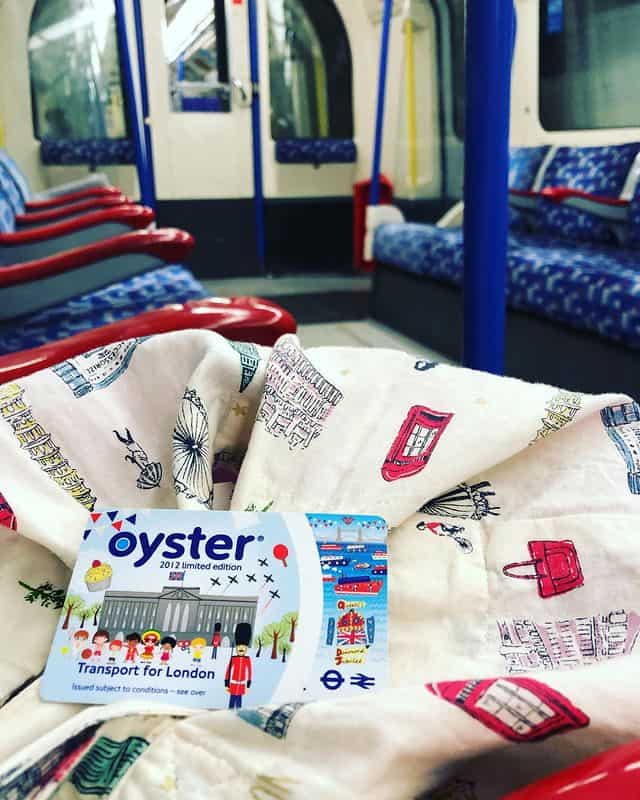
With an Oyster Card, you can travel on most public transportation, including trams, buses, Tube, London Overground, Elizabeth line, DLR, River Bus, and most National Rail services.
It is a Pay as you go (PAYG) payment card that only deducts your credit balance each time you make a journey. The Pay as you go rates differ on whether you are traveling on buses and trams alone or all public transportation.
Oyster Cards need to be topped up to add more credit if your balance is low or zero, which can be done using the TfL Oyster and contactless app. The app is also where you can manage your Oyster Card account, check your balance, and plan your journey.
For more information, read the Complete Guide To Oyster Card.
Visitor Oyster Card
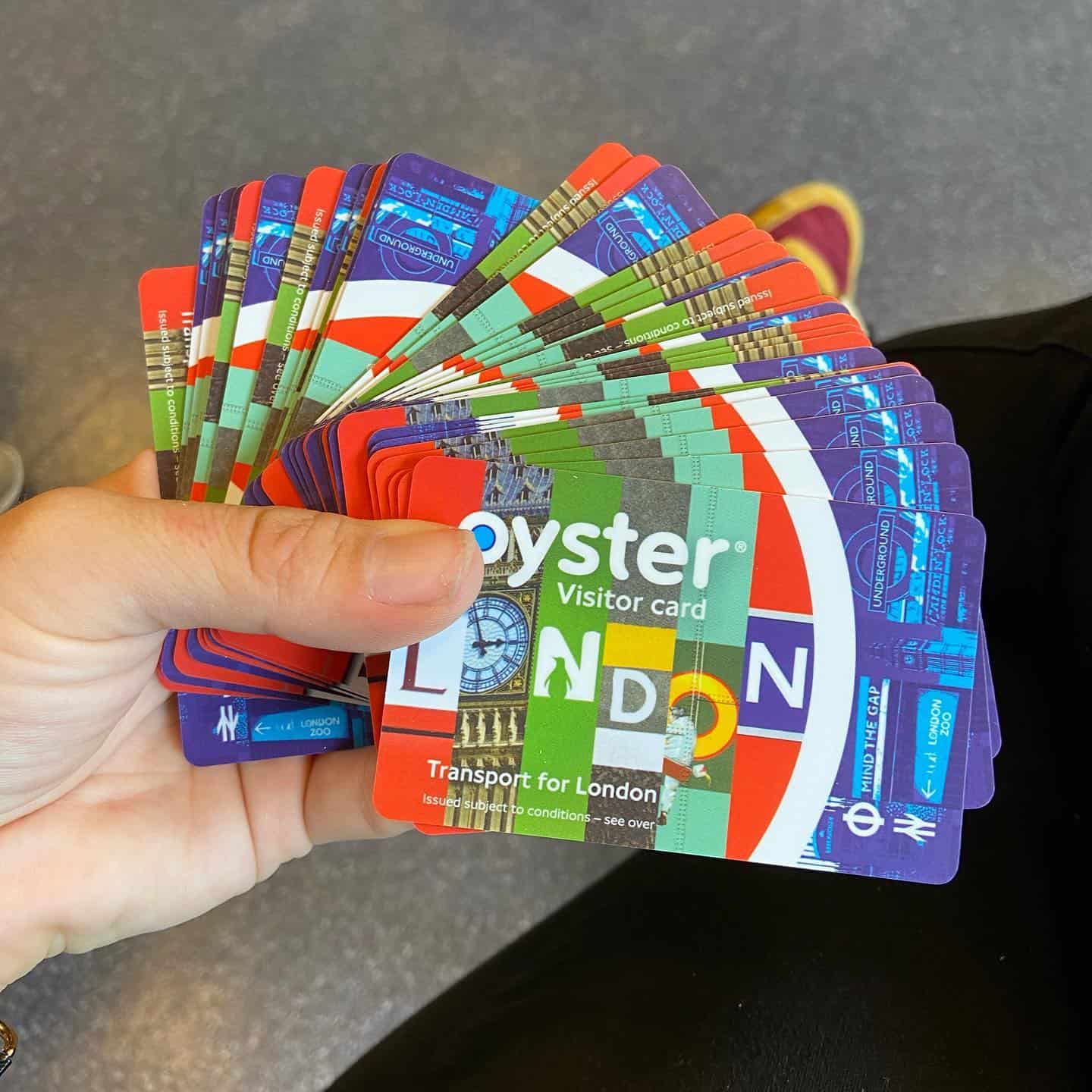
A Visitor Oyster Card is similar to a regular Oyster Card. It is a Pay as you go card and can be used for trams, buses, Tube, DLR, London Overground, Elizabeth line, and most National Rail services in London. The card is only purchasable by tourists or travelers coming from areas outside London.
It can be purchased from the Visitor Shop website, UK locations outside London, and your country. If purchased online, the card is mailed straight to your doorstep to save time and for your convenience.
All Visitor Oyster Cards have a non-refundable £5 deposit, on top of the actual initial credit, ranging from £10 to £50.
Contactless Card and Contactless Device
A Contactless Card is another type of Pay as you go card used for journeys made on transportation with a Contactless system. The card is simply your own bank card that has a Contactless feature.
If your bank card has a Contactless symbol (four curved lines similar to a signal), then you can automatically use it as payment.
However, check with your bank issuer first if it is allowed to be used in London as not all non-UK Contactless Cards are accepted.
Aside from Contactless Cards, you can also use Contactless devices with mobile payments such as Apple Pay, Barclaycard Contactless Mobile, bPay, Fitbit Pay, Garmin Pay, Google Pay, and Samsung Pay.
To learn more about Contactless Cards and devices, read How to Use Contactless Card on London Transport.
Travelcard
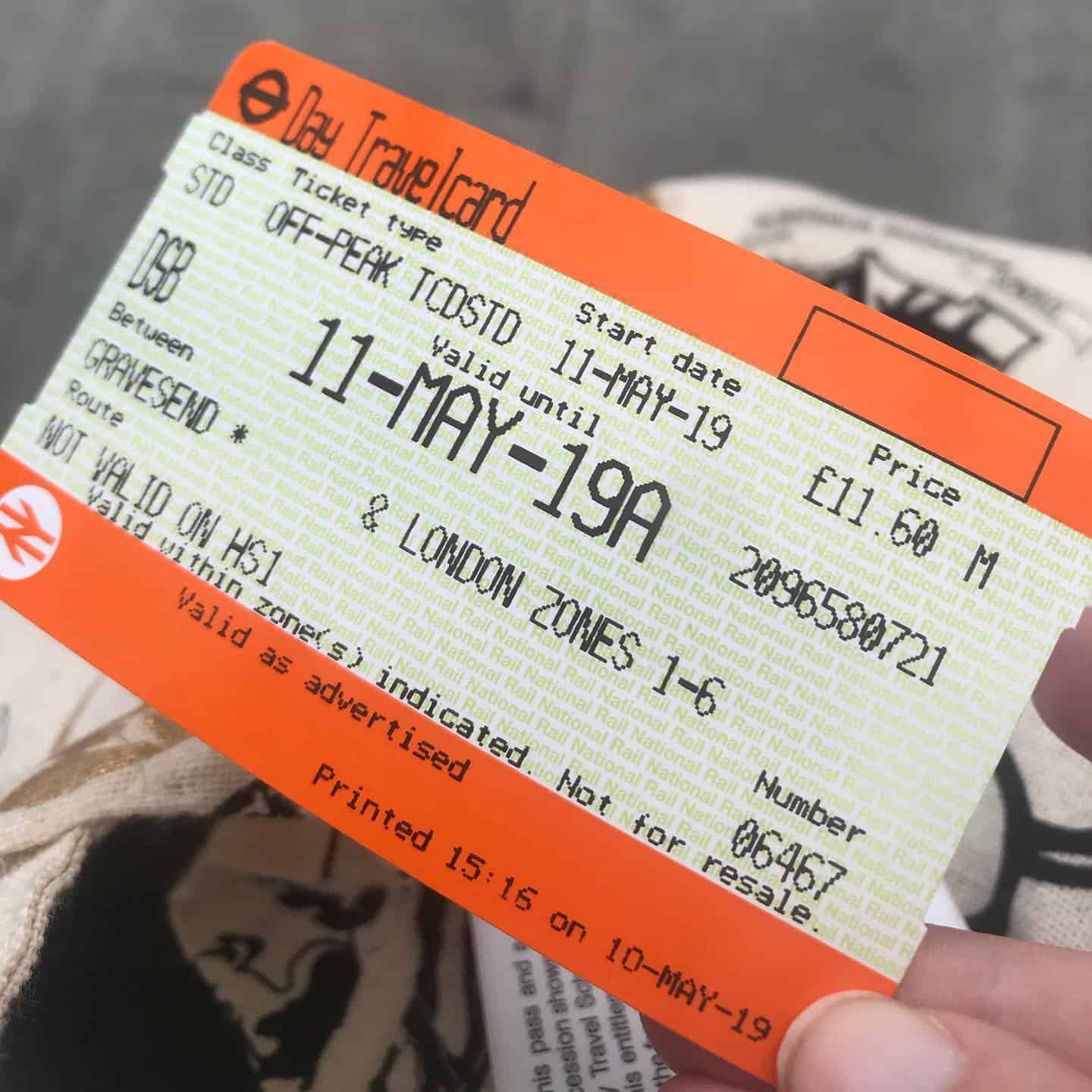
Aside from Pay as you go payments, you can also opt for unlimited travel with a Travelcard. Travelcards offer unlimited access to trams, buses, Tube, DLR, London Overground, Elizabeth line, and National Rail, and discounts to Emirates Air Line and River Boat. When you purchase a Travelcard, you can choose the Zone validity, from Zone 1 to Zone 9.
To use a Travelcard for trams, make sure your Travelcard is valid for Zone 3, Zone 4, Zone 5, or Zone 6. Travelcards have three types: Travelcard season tickets, Day Travelcards, and Group Day Travelcard.
To learn more about Travelcards, check the guide Get Unlimited Travel With A London Travel Card.
London Trams Fares
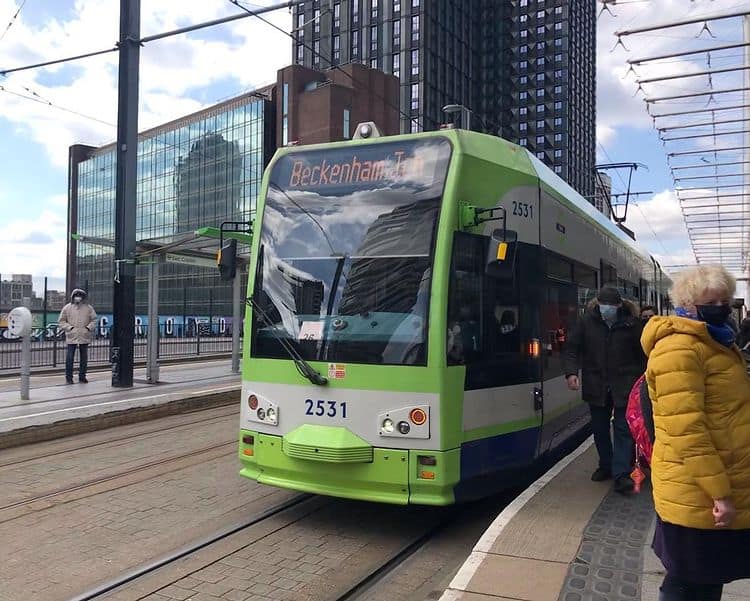
There is a standard fare if you travel by bus and tram alone or using all public transportation. For bus and tram journeys only, £1.65 is the fixed Pay as you go rate for adults and is even lower for children.
Daily caps and Bus and Tram Passes have a variety of rates per passenger type and ticket.
To learn more about Tram fares, refer to the price table below of Pay as you go, daily caps, and One Day, 7 Day, Monthly, and Annual Bus & Tram Pass.
Pay as you go Caps and Bus & Tram Passes
| Pay as you go | Daily Cap | One Day Bus & Tram Pass | 7 Day Bus & Tram Pass (Weekly Bus Pass) | Monthly Bus & Tram Pass | Annual Bus & Tram Pass | |
| Hopper Fare | £1.65 London single bus fare (Unlimited travel within one hour of use) | |||||
| 5 to 10 years old | FREE travel on buses and trams. A 5-10 Zip Oyster photocard is not needed. | |||||
| 11 to 15 years old | FREE travel on buses and trams with an 11-15 Zip Oyster photocard. | |||||
| 11 to 15 years old (Without a Zip Oyster Photocard) | £0.80 | £2.40 | £11.60 | £44.60 | £464
|
|
| 16+ years old | FREE travel on buses and trams for London residents who have a 16+ Zip Oyster photocard. | |||||
| 16+ years old (living outside London) | £0.80 | £2.40 | £11.60 | £44.60 | £464
|
|
| 18+ Student (With 18+ Student Oyster photocard) | £1.65 | £4.95 | £16.30 | £62.60 | £652
|
|
| Apprentice (With Apprentice Oyster photocard) | £1.65 | £4.95 | £16.30 | £62.60 | £652
|
|
| Adult | £1.65 | £4.95/ Or Weekly Cap £23.30 (Monday to Sunday) | £5.50 | £23.30 | £89.50 | £932
|
| Jobcentre Plus (With a Jobcentre Plus Travel Discount) | £0.80 | £2.40 | £11.60 | £44.60 | Not Available
|
|
| Bus & Tram Discount (With a Bus & Tram Discount photocard) | £0.80 | £2.40 | £11.60 | £44.60 | Not Available
|
|
| Freedom Pass | FREE travel on all TfL services for those with Older Person’s Freedom Pass (from 9:00 am on weekdays or anytime on the weekends) and Disabled Person’s Freedom Pass (anytime on weekdays and weekends). | |||||
The rates are higher for journeys that require transportation other than bus and tram. It depends on the duration and the number of zones included in the card.
Keep in mind that stations in London are categorized into Fare Zones: Zone 1 to Zone 9.
Fare Zones are used to determine the fare for each journey.
Generally, the more zones your card covers, the higher the fare. To know more about the zones of your desired destination, refer to the Tube and Rail Maps of TfL.
The map shows the zone number divisions through gray and white shaded lines or areas with numbers 1 to 9 written on them.
The table below is the adult rate for Pay as you go caps and Travelcard. Prices are set for the tram, bus, Tube, DLR, most Elizabeth line services, London Overground, Emirates Air Line, Thames Clippers River Bus services, and most National Rail services.
It does not include trips made on Southeastern high speed and Heathrow Express services.
Pay as you go Caps and Travelcard Adult Rates
(The list of Pay as you go caps and Travelcard prices for 5 to 10 years old, 11 to 15 years old, 16+ years old 18+ students, and Apprentices are indicated in the Tube and rail fares.)
| Zone | Pay as you go caps
(Adult Rate) |
Travelcard (Adult Rate) | ||||||
| Daily Peak | Daily Off-peak | Monday to Sunday | Day Anytime | Day Off-peak | 7 Day | Monthly | Annual | |
| Zones 1 only | £7.70 | £7.70 | £38.40 | £14.40 | £14.40 | £38.40 | £147.50 | £1,536 |
| Zones 1-2 | £7.70 | £7.70 | £38.40 | £14.40 | £14.40 | £38.40 | £147.50 | £1,536 |
| Zones 1-3 | £9.00 | £9.00 | £45.20 | £14.40 | £14.40 | £45.20 | £173.60 | £1,808 |
| Zones 1-4 | £11.00 | £11.00 | £55.20 | £14.40 | £14.40 | £55.20 | £212.00 | £2,208 |
| Zones 1-5 | £13.10 | £13.10 | £65.70 | £20.30 | £14.40 | £65.70 | £252.30 | £2,628 |
| Zones 1-6 | £14.10 | £14.10 | £70.30 | £20.30 | £14.40 | £70.30 | £270.00 | £2,812 |
| Zones 1-7 | £15.30 | £14.10 | £76.50 | £25.70 | £15.30 | £76.50 | £293.80 | £3,060 |
| Zones 1-8 | £18.10 | £14.10 | £90.30 | £25.70 | £15.30 | £90.30 | £346.80 | £3,612 |
| Zones 1-9 | £20.00 | £14.10 | £100.20 | £25.70 | £15.30 | £100.20 | £384.80 | £4,008 |
| Zone 2 only | £7.70 | £7.70 | £28.80 | £14.40 | £14.40 | £28.80 | £110.60 | £1,152 |
| Zones 2-3 | £9.00 | £9.00 | £28.80 | £14.40 | £14.40 | £28.80 | £110.60 | £1,152 |
| Zones 2-4 | £11.00 | £11.00 | £31.90 | £14.40 | £14.40 | £31.90 | £122.50 | £1,276 |
| Zones 2-5 | £13.10 | £13.10 | £38.20 | £20.30 | £14.40 | £38.20 | £146.70 | £1,528 |
| Zones 2-6 | £14.10 | £14.10 | £48.10 | £20.30 | £14.40 | £48.10 | £184.80 | £1,924 |
| Zones 2-7 | £15.30 | £14.10 | £49.90 | £25.70 | £15.30 | £49.90 | £191.70 | £1,996 |
| Zones 2-8 | £18.10 | £14.10 | £67.90 | £25.70 | £15.30 | £67.90 | £260.80 | £2,716 |
| Zones 2-9 | £20.00 | £14.10 | £67.90 | £25.70 | £15.30 | £67.90 | £260.80 | £2,716 |
| Zone 3 only | £9.00 | £9.00 | £28.80 | £14.40 | £14.40 | £28.80 | £110.60 | £1,152 |
| Zones 3-4 | £11.00 | £11.00 | £28.80 | £14.40 | £14.40 | £28.80 | £110.60 | £1,152 |
| Zones 3-5 | £13.10 | £13.10 | £31.90 | £20.30 | £14.40 | £31.90 | £122.50 | £1,276 |
| Zones 3-6 | £14.10 | £14.10 | £38.20 | £20.30 | £14.40 | £38.20 | £146.70 | £1,528 |
| Zones 3-7 | £15.30 | £14.10 | £49.90 | £25.70 | £15.30 | £49.90 | £191.70 | £1,996 |
| Zones 3-8 | £18.10 | £14.10 | £67.90 | £25.70 | £15.30 | £67.90 | £260.80 | £2,716 |
| Zones 3-9 | £20.00 | £14.10 | £67.90 | £25.70 | £15.30 | £67.90 | £260.80 | £2,716 |
| Zone 4 only | £11.00 | £11.00 | £28.80 | £14.40 | £14.40 | £28.80 | £110.60 | £1,152 |
| Zones 4-5 | £13.10 | £13.10 | £28.80 | £20.30 | £14.40 | £28.80 | £110.60 | £1,152 |
| Zones 4-6 | £14.10 | £14.10 | £31.90 | £20.30 | £14.40 | £31.90 | £122.50 | £1,276 |
| Zones 4-7 | £15.30 | £14.10 | £36.10 | £25.70 | £15.30 | £36.10 | £138.70 | £1,444 |
| Zones 4-8 | £18.10 | £14.10 | £60.80 | £25.70 | £15.30 | £60.80 | £233.50 | £2,432 |
| Zones 4-9 | £20.00 | £14.10 | £60.80 | £25.70 | £15.30 | £60.80 | £233.50 | £2,432 |
| Zone 5 only | £13.10 | £13.10 | £28.80 | £20.30 | £14.40 | £28.80 | £110.60 | £1,152 |
| Zones 5-6 | £14.10 | £14.10 | £28.80 | £20.30 | £14.40 | £28.80 | £110.60 | £1,152 |
| Zones 5-7 | £15.30 | £14.10 | £36.10 | £25.70 | £15.30 | £36.10 | £138.70 | £1,444 |
| Zones 5-8 | £18.10 | £14.10 | £60.80 | £25.70 | £15.30 | £60.80 | £233.50 | £2,432 |
| Zones 5-9 | £20.00 | £14.10 | £60.80 | £25.70 | £15.30 | £60.80 | £233.50 | £2,432 |
| Zone 6 only | £14.10 | £14.10 | £28.80 | £20.30 | £14.40 | £28.80 | £110.60 | £1,152 |
| Zones 6-7 | £15.30 | £14.10 | £36.10 | £25.70 | £15.30 | £36.10 | £138.70 | £1,444 |
| Zones 6-8 | £18.10 | £14.10 | £60.80 | £25.70 | £15.30 | £60.80 | £233.50 | £2,432 |
| Zones 6-9 | £20.00 | £14.10 | £60.80 | £25.70 | £15.30 | £60.80 | £233.50 | £2,432 |
| Zone 7 only | £15.30 | £14.10 | £36.10 | £25.70 | £15.30 | £36.10 | £138.70 | £1,444 |
| Zones 7-8 | £18.10 | £14.10 | £60.80 | £25.70 | £15.30 | £60.80 | £233.50 | £2,432 |
| Zones 7-9 | £20.00 | £14.10 | £60.80 | £25.70 | £15.30 | £60.80 | £233.50 | £2,432 |
| Zone 8 only | £18.10 | £14.10 | £60.80 | £25.70 | £15.30 | £60.80 | £233.50 | £2,432 |
| Zones 8-9 | £20.00 | £14.10 | £60.80 | £25.70 | £15.30 | £60.80 | £233.50 | £2,432 |
How to Use London Payment Cards at Trams
Touch in and touch out on the yellow card reader are needed for all public transportation except for buses and trams.
Before riding the tram, pay the tram fare at the tram stop by tapping the card on the yellow card reader. You only have to touch in once upon entering the tram stop and it is not necessary to touch out.
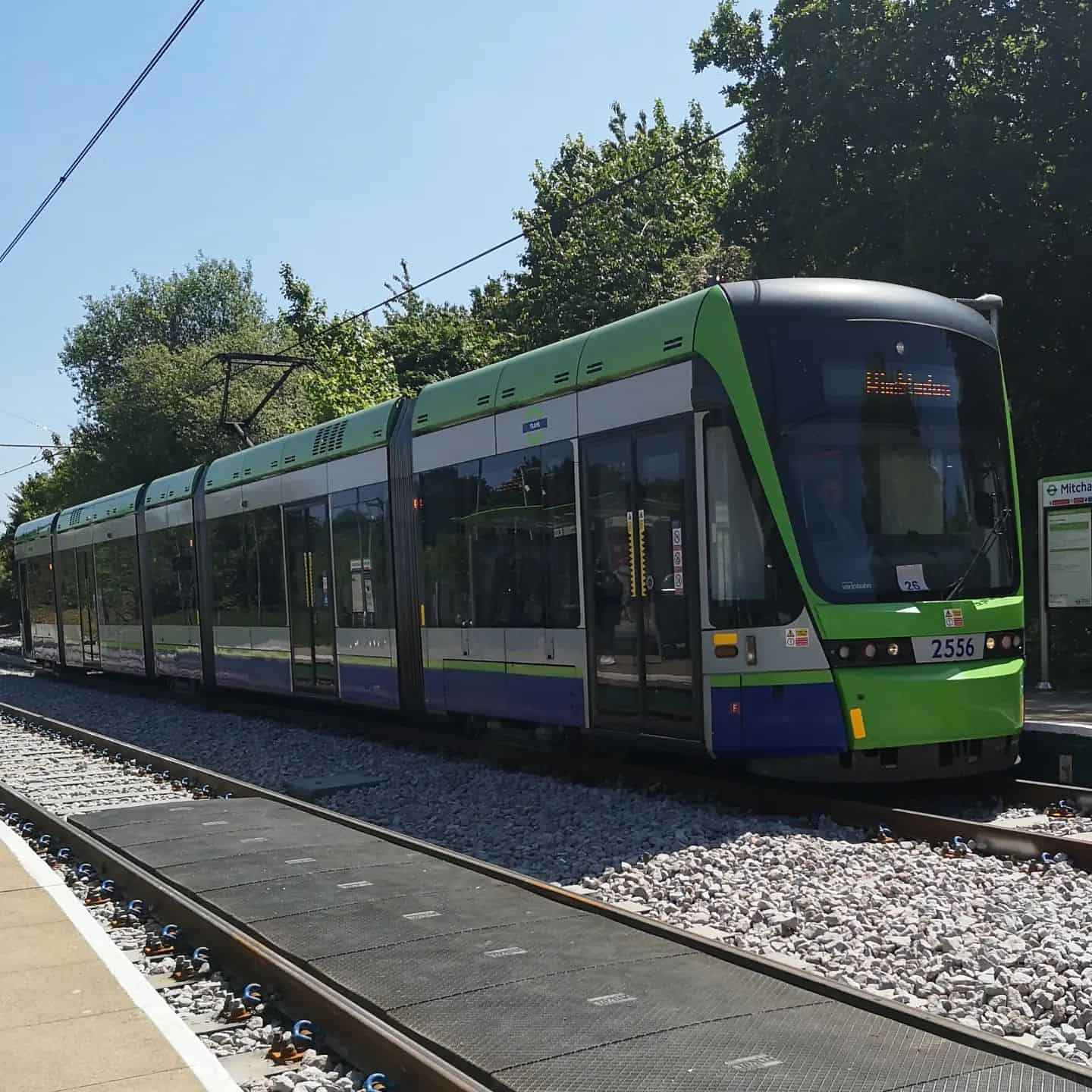
If you are interchanging to other lines on London Underground or National Rail, remember to touch in again on the station interchange to avoid penalty fares.
For journeys starting from Wimbledon Tram Stop, go to Platform 10 and touch in at the yellow “tram-only” readers. If you have already touched in at the station entrance, you still need to touch in again at this yellow tram-only reader.
Keep in mind that you need to touch in and touch out using the same card or the same Contactless Device to avoid penalties or paying the maximum fare.
For instance, it is not allowed to touch in using an Oyster Card and touch out with a Contactless Card, or touch in with Apple Pay and touch out with Google Pay.
If you are carrying multiple payment cards in the same wallet, make sure they are separated to avoid card clashes, paying twice, or payment errors.
Bus & Tram Discount Photocard
Discounts are available when you have a Bus & Tram Discount Photocard. With a Bus & Tram Discount Photocard, you get a 50% discount on Adult Pay as you go bus and tram fares, 7 Day Bus & Tram Pass, and a Monthly Bus & Tram Pass for a maximum of six months.
If you are living in any of the boroughs of London and are between 18 and 60 years old, you are eligible for the discount.
Moreover, if you are entitled to Employment and Support Allowance, Jobseekers Allowance (minimum of 13 weeks), or Universal Credit (minimum of 13 weeks), you can still apply for a Bus & Tram Discount Photocard.
You are not eligible for the discount if you are already using other free or discount benefits. If you are eligible for the discount, you can send your application by filling out and signing the Bus & Tram Discount photocard scheme application form.
You can also get the form from London Post Offices and London Jobcentre Plus offices. To complete your application, you need to submit the following:
- Proof of identity (valid passport, ID card, bank card, full driving licence, birth certificate, Biometrics Residence Permit, Home Office Application Registration Card, Post Office Card Account card, marriage certificate, divorce or separation papers, utility bill of at least three months (mobile phone bills are not included), or NHS medical card)
- Two passport-type photographswith your full name in capitalized letters on the back of the photo
- Original benefit entitlement letter for those with Employment and Support Allowance
Once you have completed your application and documents, submit them at Participating Post Offices in London where a staff verifies them and issues a Bus & Tram Discount photocard.
After claiming your Bus & Tram Discount photocard, you need to ask the staff at Tube stations or Oyster Ticket Stops to combine it with your Oyster Card in order to get the discount.
Even though you have added your discount through the system, you still need to bring your photocard with you every time you travel.
Moreover, the discount can only be used by you alone and no one else. The photocard expires after six months and can be renewed as long as you are still eligible.
Recreational Places near Tram Stops
If you are looking for popular places to visit near a stop, here are a few places to check out.
Most of the recreational places listed below are just a few minutes away from the Tram Stop. No matter what your interests may be, these places will not let you down.
Wimbledon Village
Nearest Tram Stop: Wimbledon
Address: 24 High Street Wimbledon, London SW19 5EA, United Kingdom
Phone: 07920 195 933
National Trust – Morden Hall Park

Nearest Tram Stop: Morden Road
Address: Morden Hall Rd, London, Morden SM4 5JD, United Kingdom
Phone: +44 20 8545 6850
Museum of Croydon
Nearest Tram Stop: Church Street
Address: 1918 Katharine St, Croydon CR9 1RU, United Kingdom
Phone: +44 20 8253 1022
Fairfield Halls
Nearest Tram Stop: Wellesley Road
Address: Park Ln, Croydon CR9 1DG, United Kingdom
Phone: +44 20 3292 0002
Crystal Palace Park
Nearest Tram Stop: Beckenham Road
Address: Thicket Rd, London SE19 2GA, United Kingdom
Phone: +44 30 0303 8658
Bethlem Museum of the Mind
Nearest Tram Stop: Arena
Address: Bethlem Royal Hospital, Monks Orchard Rd, Beckenham BR3 3BX, United Kingdom
Phone: +44 20 3228 4227
Frequently Asked Questions
Are London trams accessible?
All London trams and tram stops are accessible thanks to the step-free access without needing ramps to get on board.
There are dedicated spaces for wheelchairs and intercoms for emergencies. Moreover, priority seats are available for the elderly, PWDs, and passengers with small children.
Where can I buy Bus & Tram Passes?
Bus & Tram Pass season tickets are available at ticket machines at Tube, London Overground, and most Elizabeth line stations, Oyster Ticket Stops, Visitor Centres, TfL Oyster and contactless app, and online via your contactless and Oyster account.
How many bus routes does London Trams serve?
There are several bus routes available at each tram stop. For instance, Wimbledon Tram Stop is near Wimbledon Bus Station, which serves bus route 164.
Mitcham Road Tram Stop is near Mitcham Bus Stop (Stop V), which serves bus routes 118, 280, N44, and N133. You can check the bus routes available at each tram stop by using Google Maps and searching nearby bus stops.
How can I plan my Tram journey?
With the help of TfL, you can plan your journey using their travel tools. The tools inform you of the tram status updates, planned closures, and live arrivals and departures. The TfL Go app also helps you travel with updated maps, routes, and directions.
Ride a Tram on Your Next London Trip
Now that you know how to ride a tram, you can travel like a local with ease. It is one of London’s most accessible public transportation, best for all types of travelers.
Don’t forget these tips and advice from this London Tram guide so you don’t run into any trouble.
Do you have any recommendations to share? Post them in the comments section below and we would love to read them.
Hopefully, this guide was able to clear up all your confusion and questions about riding London trams.

